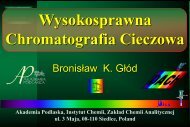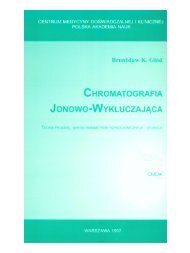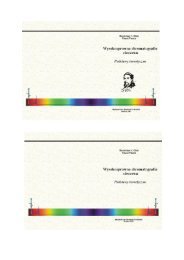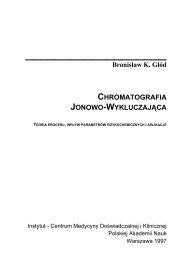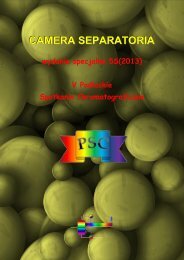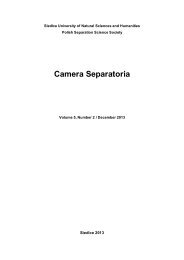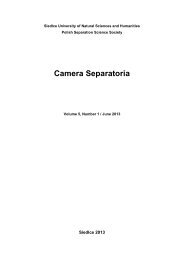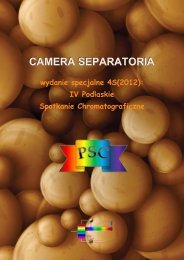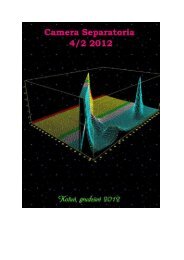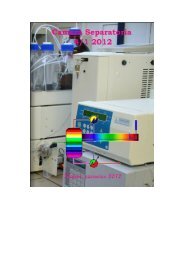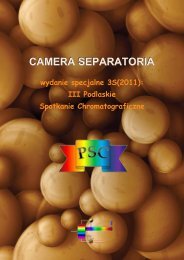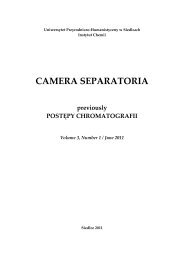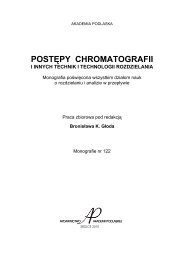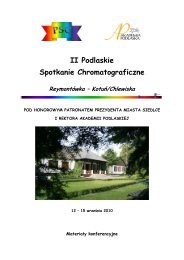CamSep 3 2
You also want an ePaper? Increase the reach of your titles
YUMPU automatically turns print PDFs into web optimized ePapers that Google loves.
CAMERA SEPARATORIA previously POSTĘPY CHROMATOGRAFII<br />
Volume 3, Number 2 / December 2011, 319-327<br />
Anita SKRZYPCZAK, Marian KAMIŃSKI *<br />
Katedra Inżynierii Chemicznej i Procesowej, Wydział Chemiczny,<br />
Politechnika Gdańska, ul. G. Narutowicza 11/12, 80-233 Gdańsk,<br />
e-mail: mknkj@chem.pg.gda.pl*<br />
Nowa metoda rozdzielania składników oraz oznaczania<br />
kumaryny w napojach alkoholowych i w maceratach<br />
z turówki wonnej (hierochloe odorata) z wykorzystaniem<br />
RP-HPLC i przepływu zwrotnego eluentu w kolumnie<br />
New method of separation of components and the determination<br />
of the coumarin in alcoholic beverages and a sweet grass<br />
(hierochloe odorata) macerates using RP-HPLC and reverse<br />
flow of an eluent in the column (backflush)<br />
Streszczenie: Kumaryna (1,2-benzopiron) jest naturalną substancją występującą w roślinach<br />
stosowanych jako dodatki smakowe i aromatyczne do napojów alkoholowych. W wyniku pojawienia<br />
się doniesień o toksyczności kumaryny, ograniczono wykorzystanie ekstraktów roślinnych<br />
zawierających ją jako dodatek do żywności i napojów. Ustalono, że maksymalny poziom<br />
zawartości kumaryny, bezpieczny dla ludzi w żywności i napojach bezalkoholowych, wynosi<br />
2 mg/kg, a w napojach alkoholowych wynosi 10 mg/kg. Biorąc pod uwagę powyższe, niezwykle<br />
ważne jest dysponowanie szybką i selektywną metodą oznaczania zawartości kumaryny zarówno<br />
w napojach alkoholowych, jak i w maceratach turówki wonnej, stosowanych do produkcji<br />
smakowych napojów alkoholowych. Praca prezentuje wyniki badań nad warunkami rozdzielania<br />
i oznaczania kumaryny w napojach alkoholowych i maceratach z turówki wonnej wykorzystywanych<br />
do produkcji wódek ziołowych. Warunki analityczne dobrano w ten sposób, by zapewnić<br />
optymalną selektywność rozdzielania w jak najkrótszym czasie. W tym celu zastosowano odwrócony<br />
układ faz RP-HPLC oraz detektor UV-DAD.<br />
Słowa kluczowe: kumaryna, 1,2-benzopiron, Hierochloe odorata, odwrócony układ faz wysokosprawnej<br />
chromatografii cieczowej RP-HPLC, przepływ zwrotny eluentu w kolumnie<br />
Abstract: The Coumarin (1.2 benzopiron) is a natural substance occurring in plants which is used as<br />
a flavor and an aroma of alcoholic beverages. As a result of reports concerning toxicity of the coumarin,<br />
the use of the plants extracts, which were food and beverages additives is reduced. It was established<br />
that the maximum content of coumarin, safe for human use in food and soft drinks is 2 mg/kg,<br />
in alcoholic drinks is 10 mg/kg. Given the above, it is very important to possess a rapid and selective<br />
method for the determination of coumarin in the flavoured alcoholic beverages, as well as macerates<br />
of Hierochloe odorata used to produce the alcoholic beverages. This paper presents results of research<br />
on the conditions of separation and determination of coumarin in alcoholic beverages and macerates<br />
of the sweet grass used for the production of herbal vodka. Analytical conditions were defined to<br />
ensure optimum selectivity of separation in the shortest possible time. For this purpose, the reversed<br />
phase RP-HPLC and UV-DAD detector, were used.<br />
Key words: coumarin, 1.2-benzopyrone, Hierochloe odorata, Reversed-Phase High Performance<br />
Liquid Chromatography RP-HPLC, reverse flow of an eluent in the column (backflush)<br />
Vol. 3, No 2/2011<br />
Camera Separatoria




